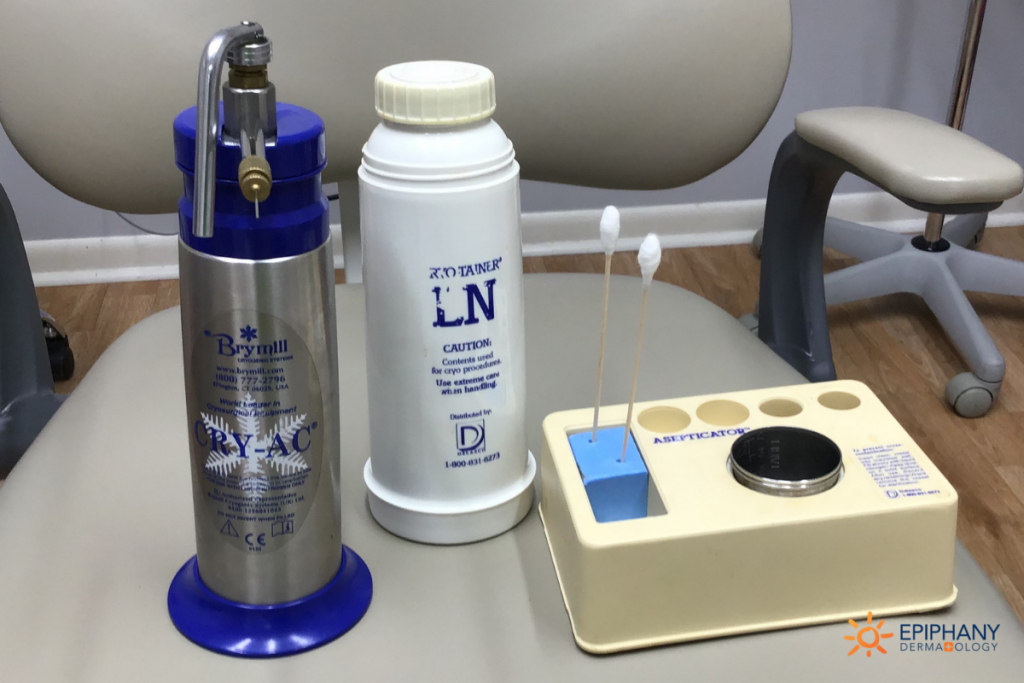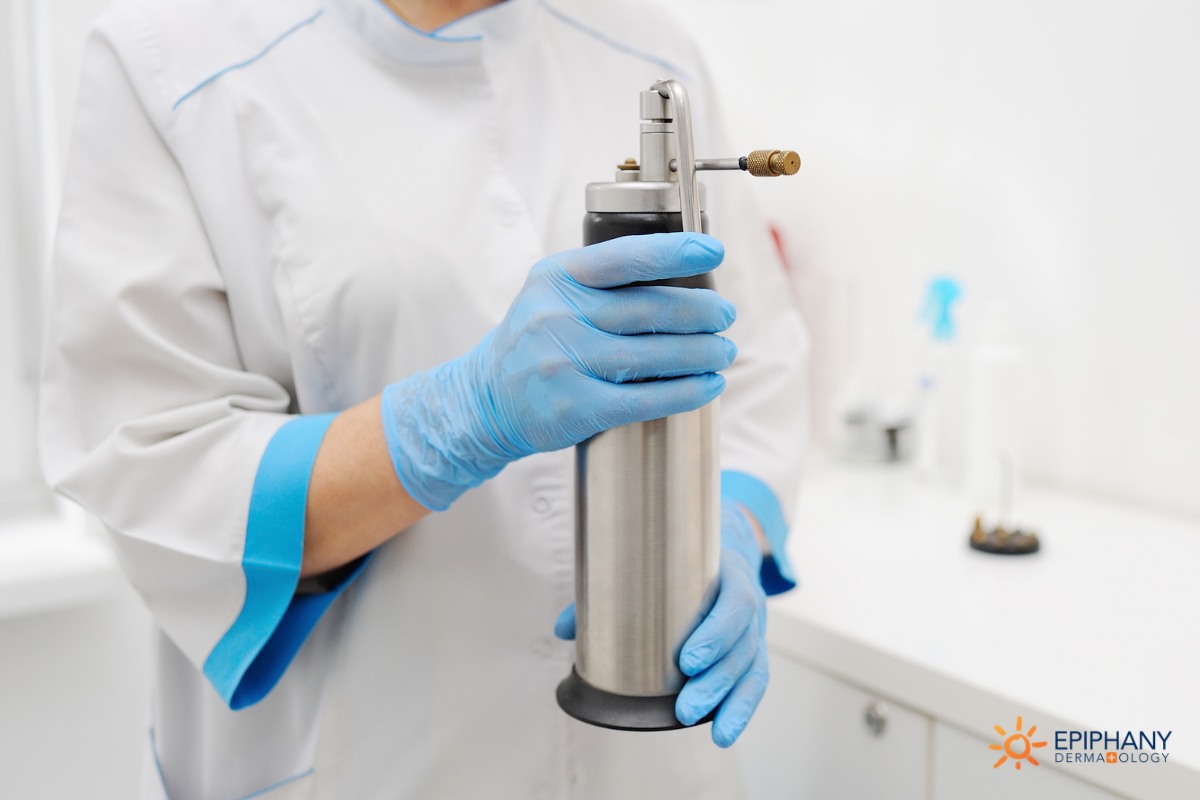Cryosurgery, also known as cryosurgical destruction, uses liquid nitrogen to treat various skin lesions. This intense cold liquid (liquid nitrogen), with a temperature of -196 °C (-320 °F), is applied to target areas to destroy unwanted cell structures.
Cryosurgery vs. Cryotherapy
What’s the difference? Cryotherapy is a light application of liquid nitrogen used for cosmetic purposes while cryosurgery is reserved for destruction of various skin lesions (growths).
What Symptoms Does Cryosurgery Treat?
Cryosurgery can be used to treat many benign, precancerous skin lesions as well as certain forms of minor or shallow skin cancers.
What is cryosurgery specifically used to treat? Cryosurgery is an effective option for treating:
- The common wart (often responds to cryosurgery if other medical therapy has failed).
- Pre-cancerous lesions (actinic keratoses) resulting from chronic sun damage.
- Other age-related lesions such as seborrheic keratosis (benign warty lesions).
- Angiomas (blood vessel growths).
- Sebaceous hyperplasia (oil gland moles).
- Fibromas and other skin tags.
We use a lighter application of liquid nitrogen (cryotherapy) to treat cosmetic issues such as acne scarring and certain forms of dilated blood vessels.
How Does Cryosurgery Differ From Other Surgical Treatments?
General cosmetic results tend to be slightly better than other surgical approaches to treating these medical skin conditions. Cryosurgery has become a common treatment used in most dermatology practices throughout the world.
What Should You Expect During Cryosurgery?
Patients do not need any specific preparation before cryosurgery. Before we begin the treatment, we may need to clean the area with rubbing alcohol, but that’s often optional.
There are two methods of application for cryosurgery:
- Spray technique: We spray the liquid nitrogen directly onto the skin lesion. The patient will feel a slight air pressure and a stinging, cold sensation.
- Direct application: We apply the liquid nitrogen directly to the lesion with a saturated cotton swab. This also creates a cold burn sensation for the patient.
Both methods are usually less painful than injecting a local anesthetic.
 Image provided by Dr. Terry Pursley, Epiphany Dermatology
Image provided by Dr. Terry Pursley, Epiphany Dermatology
Depending on the thickness and depth of the lesion, we use either a single or double freeze-thaw cycle to completely destroy the targeted cells. Each cycle requires the application of liquid nitrogen for five to seven seconds. Superficial lesions often only require the single freeze-thaw cycle, while more severe lesions require a double freeze-thaw cycle.
After treatment, these lesions often look like blisters as they heal — similar to if a small spot of grease dropped on your skin. Patients may also experience slight hiving on the area for two to three days. Some patients have very little reaction and only experience slight swelling after treatment.
Cryosurgery healing time takes about 12-14 days, depending on the degree of freezing. The lesions die within 36 hours of cryosurgery, but they don’t disappear right away. After the cells die, they dry out into a crust-like scab until they come off.
Lesions peel off naturally in 10-14 days. Do not try to tear the blister off before then. If you do, you increase your risk of infection. The chance of infection is very rare unless you scratch the wound open.
Instead, let the dead cells serve as a natural bandage to protect the wound and allow for more complete healing until it flakes off on its own.
Cryosurgery FAQ’s
What are the side effects of cryosurgery?
Local swelling and occasional blistering are a common side effect of cryosurgery.
People are naturally alarmed if they see a blood blister, however, this a common side effect. We see blood blisters and swelling particularly over the thinner skin on the top of the hands or forearms. We provide all patients with instructions on how to manage blood blisters to keep them from over-expanding in the event they occur.
Occasionally, patients experience after-pains from the treatment. For most patients, the superficial pain is short-lived. Usually, the pain subsides within ten minutes of leaving the office, but there are cases where patients have mild rebound pain later in the evening or the next day. For this side effect, we advise patients to take arthritis-strength Tylenol, ibuprofen, or Aleve.
Is cryosurgery 100% effective?
No surgery is guaranteed to be 100% effective. However, when skin lesions are appropriately selected, cryosurgery is 96-98% effective. There’s only an occasional case where the treatment must be redone at a later date.
Will there be any scarring or color changes?
People tend to have very little scarring on this skin after a cryosurgical treatment. Particularly, patients with lighter skin have very good cosmetic results that leave minimal or no pigmentation changes or scarring. Patients with darker skin tones may notice a slight color change — either lighter or darker. Sometimes, this is permanent, but often the skin returns to its original pigment within six months.
How do I take care of the spots after cryosurgery?
Post-operative care is relatively easy for cryosurgery. We recommend washing the area with a gentle antibacterial soap twice a day. Then, cover the wound with vaseline. You usually don’t need antibiotic creams after this procedure, but this is decided by your Dermatologist. Vaseline is used most often to cover the spot and prevents infection while softening the dead skin cells that need to slough off.
There’s no need to bandage this type of treatment site unless you’ve otherwise injured it by prematurely removing the blister.
What does cryosurgery cost?
If a lesion qualifies for cryosurgery, it’s often the most cost-effective treatment option.
The exact cryosurgery cost depends on your insurance coverage. This is a simple procedure, but it is a form of surgery and is coded as such for insurance.
Cryosurgery is one of the least expensive types of surgeries. It’s equivalent in cost to the removal of skin tags and less expensive than a shaving removal or an electrosurgical destruction. Cryosurgery costs significantly less than an excision. However, each individual lesion is priced separately, so more lesions will cost more.
Additional Resources
- Freezing Spots At Home Vs. At The Dermatologist: What’s The Difference?
- How Much Does Mole Removal Cost?
Click here to find an Epiphany provider near you.


